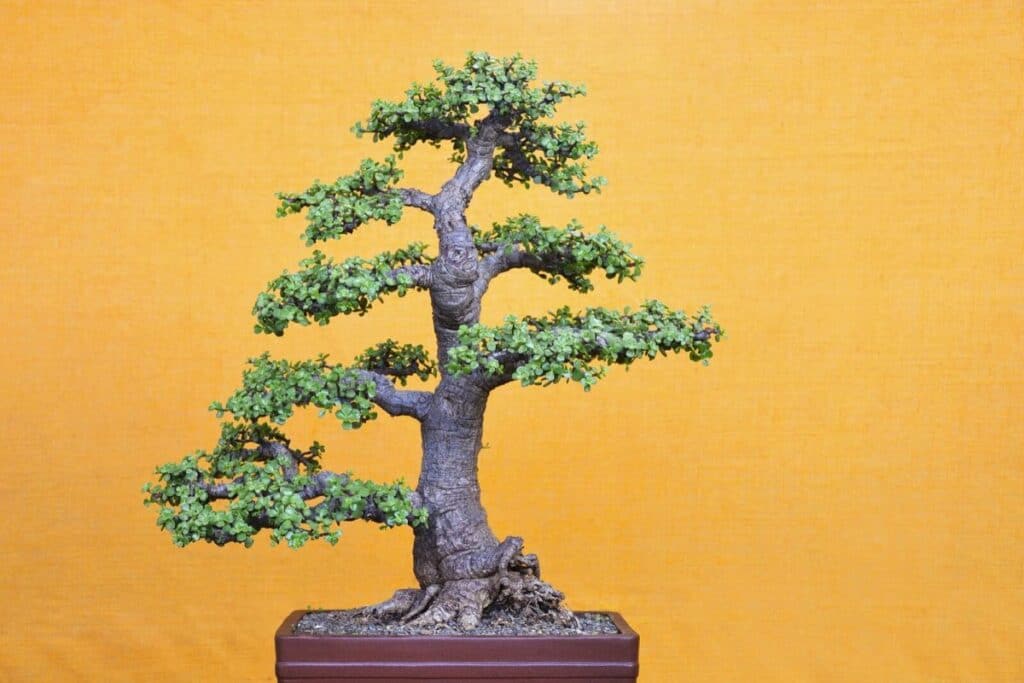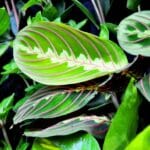Portulacaria afra – the name might sound like a mouthful, so it might be easier to refer to this plant by other names such as elephant bush, porkbush, dwarf jade plant, and spekboom, in Afrikaans, just to name a few!
An easy to care for plant, the elephant bush is often used in bonsai cultivation. However, if you’re lucky enough to live in a frost-free area, you can even use Portulacaria afra in your outdoor landscaping!
Native to South Africa, this dwarf jade plant is typically grown outdoors in full sun in its native range. However, like most other succulents, it can also be grown as a bonsai tree indoors. Here’s what you need to know!
Most gardeners will choose to grow this plant as a bonsai specimen, though. Here’s what you need to know.
Interesting Facts about Portulacaria Afra Bonsai
| Height | 10 inches |
| Width | 2 inches |
| Sunlight | Full sunlight |
| Flowering time length | N/A |
| Lifespan | 200 years |
| Scientific name | Portulacaria afra |
| Common names | Dwarf jade bonsai, small leaf jade, elephant plant, purslane tree |
| Native range | South Africa |
Types of Portulacaria Afra Bonsai
A small-leaved succulent plant native to South Africa, Portulacaria afra is a small, succulent plant that produces compact growth and rounded pads with thick trunk. It grows quickly and is incredibly hardy.
As you might expect from the name, the tender new leaves of this plant is a favorite species in an elephants diet!
It’s also one of the most popular choices of bonsai styles for indoor growers due to its fine branch structure and the fact that it’s such a small tree.
There aren’t many options when it comes to varieties of Portulacaria afra you can use for bonsai growing. However, there are both green and variegated options for you to choose from in most cases.
You can also choose from common bonsai cultivars like Limpopo (a large-leafed variety), Prostrata, (a low-lying option), Aurea (a cultivar with yellow leaves) and Foliis variegatus and Medio-picta (both of which are variegated types).
Other good companions for your portulacaria bonsai tree include Crassula ovata, Japanese black pine, the money tree, or the fat pork tree.
Growing Elephant Bush Bonsai from Seed or By Propagation
The elephant bush bonsai can be grown from seed or by propagation. However, it’s easiest to grow from cuttings that are propagated in the summer.
Propagation is the easiest and most successful method to grow an Elephant Bush. This can be done by either using stem cuttings or leaf cuttings.
Stem Cuttings
The first step in propagation via stem cuttings is choosing a healthy stem.
You should select a stem with a terminal bud that is healthy and mature, but not old or woody. Using a sterile knife or shears, cut the stem, making sure the cut is clean and does not crush the stem.
You’ll place your small cutting in a decent pot with new soil, adding a bit of rooting hormone to get it to take off. The best time to take this cutting is when the plant is dormant.
Leaf Cuttings
Similarly, for leaf cuttings, select a healthy, mature leaf. Gently twist the leaf from the stem, ensuring you get the entire leaf and base.
Once you have your cuttings, they need to dry before planting. This process, known as callusing, helps to prevent the cuttings from rotting when planted. Depending on the size of the cutting, this may take a few days to a week.
Once the cuttings have dried, they are ready to plant. Prepare a pot with well-draining soil, such as a mix designed for cacti or succulents. Place the cuttings on top of the soil or insert the cut end of the stem into the soil. Do not water immediately after planting to avoid causing rot.
How To Care for a Jade Bonsai
Here are some tips to help you care for your miniature jade tree!
Sunlight
Grow your Portulacaria afra indoors if you live in a temperate zone. However, do keep in mind that you can keep it outdoors as long as it is placed in full sun and is kept at temperatures above 50 degrees or so at all times.
Even when you grow the jade bonsai as an indoor bonsai tree, you will need to provide it with lots of light. In some cases, that may mean supplementing with a grow light. If you notice that the leaves have developed red edges, you are doing okay with the amount of sunlight you are providing.
Watering
Portulacaria afra trees are unique in that they can hold an exceptional amount of water in their leaves. As succulents, they don’t need to be watered very often. That said, it’s a good idea to have a solid watering schedule in place to make sure you aren’t over watering your plant and that you let the soil become completely dry.
In fact, it’s a good idea to let your plant dry out slightly between watering. In the winter, you can water as little as once every three to four weeks, especially if your plant is being grown in cooler conditions.
Once the soil dries out, though, be sure to water. This plant isn’t quite as sensitive to overwatering as other succulents can be.
Fertilizing
You only need to fertilize this great bonsai tree about once per month during the main growing season (spring to autumn). Use a normal fertilizer that is well-balanced and apply it sparingly throughout the entire pot.
In most cases, you can use the same fertilizer you use on other plants you’re growing as bonsai.
Potting and Repotting
You will need to repot your Portulacaria afra once every two years and make sure you use new bonsai soil mix every time. This should ideally be done in the spring. Place your new plant into a well-draining soil mixture. If you can, use soil that has a bit of calcined clay and pine bark in your bonsai pots.
Although most bonsai plants benefit from a gentle watering after they have been repotted, this is not something you need to do with your Portulacaria afra.
Instead, avoid watering for about one week. This will let the roots become dry and callous and can prevent fungal root rot.
Pruning a Portulacaria Afra Bonsai
You need to be careful about pruning your Portulacaria afra, as it holds water in its branches and trunk. These can cause them to bend from the excess weight.
However, when done slowly and methodically, jade tree benefits from pruning, which can force the tree to develop branches lower on its trunk. Again, drastic pruning isn’t necessary – just enough to get the plant refreshed once every few years.
Avoid using cut paste with your jade bonsai plant, as this can cause your plant to rot.
Pests and Diseases
Portulacaria afra is not prone to many diseases or pests. As long as you water it correctly and give it enough sunlight, it will do just fine and not suffer from any of the most common bonsai ailments.
That said, you should keep an eye out for pests like mealy bugs and aphids. These pests secrete honeydew that can cause the plant to become ill.
Where to Buy Dwarf Jade Plant Bonsai
You can buy Portulacaria afra bonsai from most nurseries or specialty bonsai stores.
See more: Crassula ovata bonsai tree
*Photo by RealityImages/depositphotos







